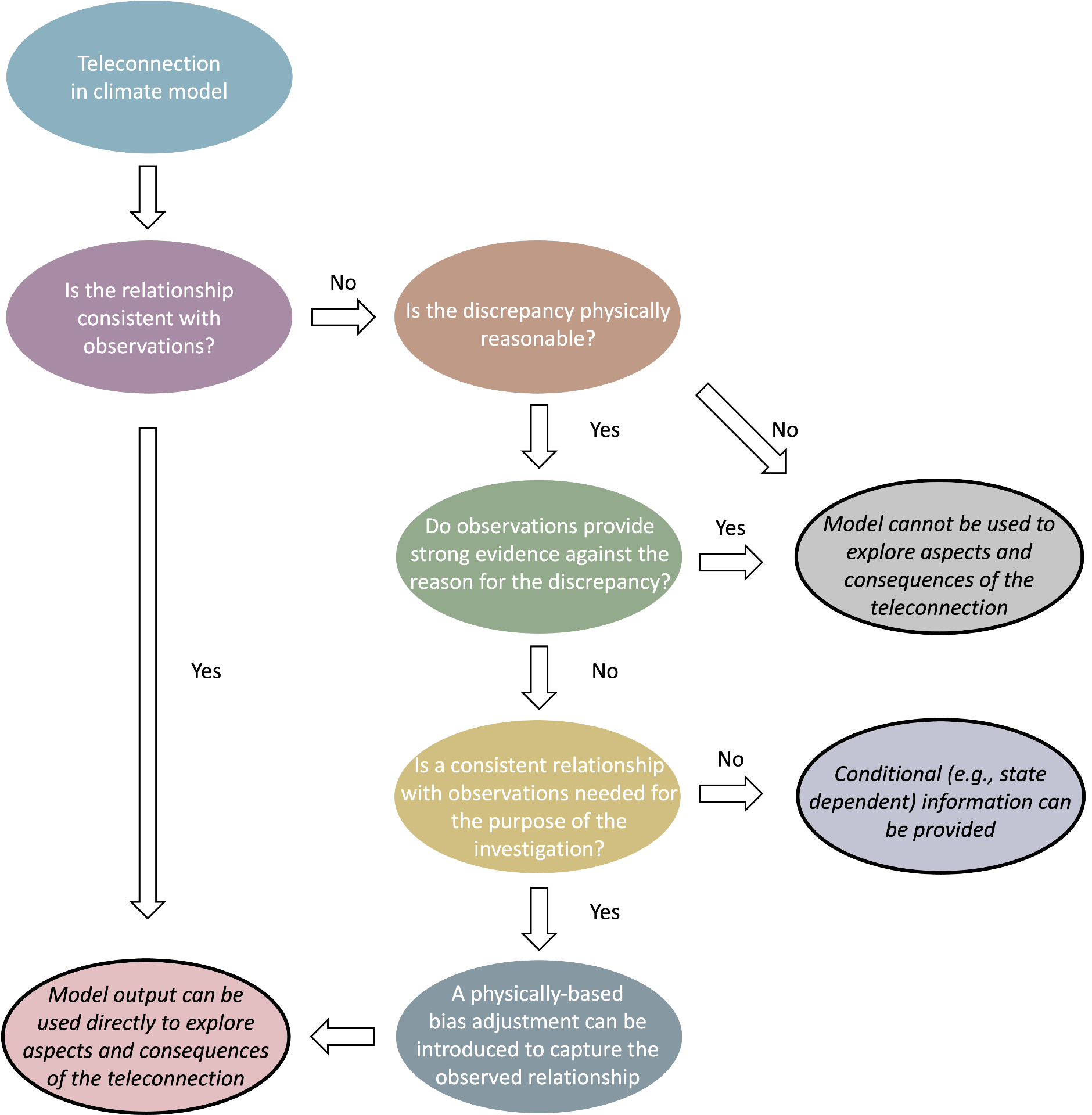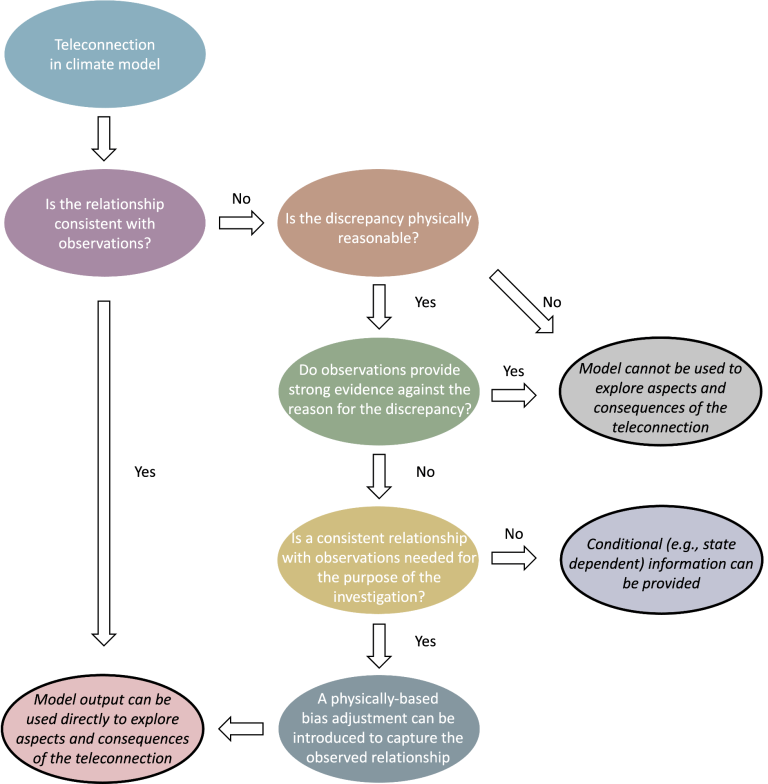go through: Dr. Xiaocen Shen
Remote connection Often manifested as recurring patterns linking weather and climate anomalies (deviations from long-term averages) over long distances around the globe (For example, Wallace and Gutzler 1981). As such, they play an important role in shaping climate change and regional climate change. A striking example is El Niño-Southern Oscillation (ENSO) teleconnection (Fig. 1). ENSO is the most significant year-to-year internal change in the climate system, Although ENSO itself occurs in the tropical Pacific and manifests as fluctuations between anomalously warm and cold conditions, it excites wave trains that propagate into the extratropics, strongly affecting precipitation and temperature in mid- and high-latitudes (e.g., Trenberth et al., 2016 ). In addition, the response of the extratropical circulation to ENSO can further affect the upward propagation of planetary waves in mid-latitudes, leading to significant changes in planetary waves in mid-latitudes. stratospheric polar vortex (SPV) Through wave-mean flow interaction (For example, Domeisen et al., 2019). In return, the induced SPV anomalies can further descend into the troposphere, regulating weather conditions in mid-latitude regions. For example, this ENSO-SPV nexus has been shown to have a strong influence on post-El Niño cooling in late winter over northern Europe (e.g., Ineson and Scaife 2009). Therefore, learn Remote connection Not only does it help to better understand changes in atmospheric circulation, it is also the key to improving forecasting capabilities.

Figure 1. Schematic diagram of ENSO teleconnection (taken from Domeisen et al., 2019)
Although observations are the starting point for studying teleconnections, limited records make it difficult to draw reliable conclusions based on observations alone. On the one hand, the climate system is complex, and relationships sometimes differ between different periods (e.g., Dong and McPhaden, 2017). On the other hand, a simple correlation between two circulations does not always indicate a physical teleconnection, sometimes it can reflect co-variations in response to other factors (Kretschmer et al. 2021).
To solve this problem, climate model simulations are widely used because they can provide a larger number of samples. However, climate models do not always agree with observed teleconnections, in which case the difference is known as Model bias.. There are two main potential reasons for this difference. First, climate models may fail to capture key physical processes and therefore fail to reproduce teleconnections. 2. Due to the limited observation sample sizes, this difference may reflect internal changes in the climate system. so, Use models with confidence to study teleconnections and related aspects, When significant differences exist, scientific judgment is required to demonstrate model applicability (e.g. Jain et al., 2023). In our recent research, we advocate the use of forensic investigative methods to understand differences between climate models and observations, which can helps Make a decision whether the model output is trustworthy.
The literal definition of forensic investigation is the scientific analysis of physical evidence at a crime scene. The logic behind it is to examine the evidence thoroughly to ascertain the facts and reveal the truth. In the context of assessing differences in teleconnection models, physics-based analyzes are needed to understand their origins and thereby provide an evidence base for deciding whether a model is suitable for a given scientific purpose. Since the logic is similar to that of solving crime puzzles, the term “forensics” is used here to describe our approach (Fig. 12). The following will take the ENSO-SPV relationship as an example to illustrate how to use forensic investigation methods to extract reliable information from model output.

Figure 2. Forensic investigation reveals logic of climate model bias (image adapted from Freepik)
In a climate model called MIROC6, the ENSO-SPV relationship is opposite to observations. At first glance, this model seems inappropriate for studying the ENSO-SPV relationship and related scientific issues. However, based on physics-based analyses, we find that the MIROC6 model actually captures relevant dynamical processes very well, including the extratropical response of ENSO, anomalous upward propagation of planetary waves, and wave-mean flow interactions in the stratosphere. It is further shown that this difference is mainly related to wave propagation within the stratosphere, ultimately leading to different SPV responses. This reflects the causal relationship between ENSO and SPV is determined by other factors and/or background states, called state dependence. Therefore, although the model shows an ENSO-SPV relationship that is opposite to the observations, it is physically reasonable.
In addition, observes shows similar state dependence to the model results, as the observed ENSO-SPV relationship is unstable and affected by other factors, such as ocean background conditions (e.g. Rao et al., 2019). Due to the limited sample size, observational evidence neither supports nor contradicts this state dependence found in the model. Therefore, depending on the specific purpose of the study, different choices can be made on how to use model simulations.
If the study does not require stable teleconnections, for example to study non-stationarity and state dependence, the model can be used directly to provide conditional information. On the other hand, if the study requires stable teleconnections consistent with observations, the model should be used only after applying physics-based bias adjustments. In the ENSO-SPV relationship case, a physics-based bias adjustment is applied to the SPV under the assumption that the state dependence is spurious, which effectively aligns the modeled ENSO-SPV relationship with the observations, thereby eliminating the model from the observations The differential surface air temperature response.
This case example illustrates how forensic methods can help us better understand the differences between modelss and observations, allowing us to make full use of the climate model output (Fig. 3). Similar physics-based methods have been widely used in climate studies in recent decades (e.g., Kretschmer et al. 2020; Shepherd 2021), providing us with further opportunities to more fully understand model performance and extract from models More informations.

Figure 3. Forensic investigation process. The direction of the arrow indicates the order in which actions are taken. Bubbles surrounded by black outlines represent conclusions about whether we can trust the model and how to use the model output.
Further reading/references:
Domeisen, DIV, Garfinkel, CI, & Butler, AH (2019). Teleconnections between the El Niño Southern Oscillation and the Stratosphere. Geophysical Reviews, 57(1), 5-47. https://doi.org/10.1029/2018rg000596
Dong, L., & McPhaden, M.J. (2017). Why has the relationship between decadal variability in the Indian and Pacific Oceans changed in recent decades? Journal of Climate, 30(6), 1971-1983. https://doi.org/10.1175/jcli-d-16-0313.1
Ineson, S., & Scaife, A. A. (2009). The role of the stratosphere in Europe's climate response to El Niño. Nature Geoscience, 2(1), 32-36. https://doi.org/10.1038/ngeo381
Jain, S., Scaife, AA, Shepherd, TG, Deser, C., Dunstone, N., Schmidt, GA, Trenberth, KE, & Turkington, T. (2023). The importance of internal variability for climate model evaluation. npj Climate and Atmospheric Sciences, 6(1), 68. https://doi.org/10.1038/s41612-023-00389-0
Kretschmer, M., Adams, SV, Arribas, A., Prudden, R., Robinson, N., Saggioro, E., & Shepherd, TG (2021). Quantifying the causal paths of teleconnections. Bulletin of the American Meteorological Society, 102(12), E2247-E2263. https://doi.org/10.1175/bams-d-20-0117.1
Kretschmer, M., Zappa, G., & Shepherd, T. G. (2020). The role of Barents-Kara sea ice loss in predicted polar vortex changes. Synoptic Climate Dynamics, 1(2), 715-730. https://doi.org/10.5194/wcd-1-715-2020
Rao, J., Garfinkel, CI, & Ren, R.C. (2019). Modulation of the northern winter stratospheric El Niño-Southern Oscillation teleconnection by PDO. Journal of Climate, 32(18), 5761-5783. https://doi.org/10.1175/jcli-d-19-0087.1
Shepard, T. G. (2021). Introducing physical reasoning into statistical practice in climate change science. Climate Change, 169(1-2), 2. https://doi.org/10.1007/s10584-021-03226-6
Trenberth, KE, Branstator, GW, Karoly, D., Kumar, A., Lau, NC, & Ropelewski, C. (1998). Progress made during TOGA in understanding and modeling global teleconnections related to tropical sea surface temperatures. Journal of Geophysical Research-Oceans, 103(C7), 14291-14324. https://doi.org/10.1029/97jc01444
Wallace, J. M., & Gutzler, D. S. (1981). Teleconnections of geopotential height fields in the Northern Hemisphere winter. Monthly Weather Review, 109(4), 784-812. https://doi.org/10.1175/1520-0493(1981)109<0784:Titghf>2.0.Co;2
